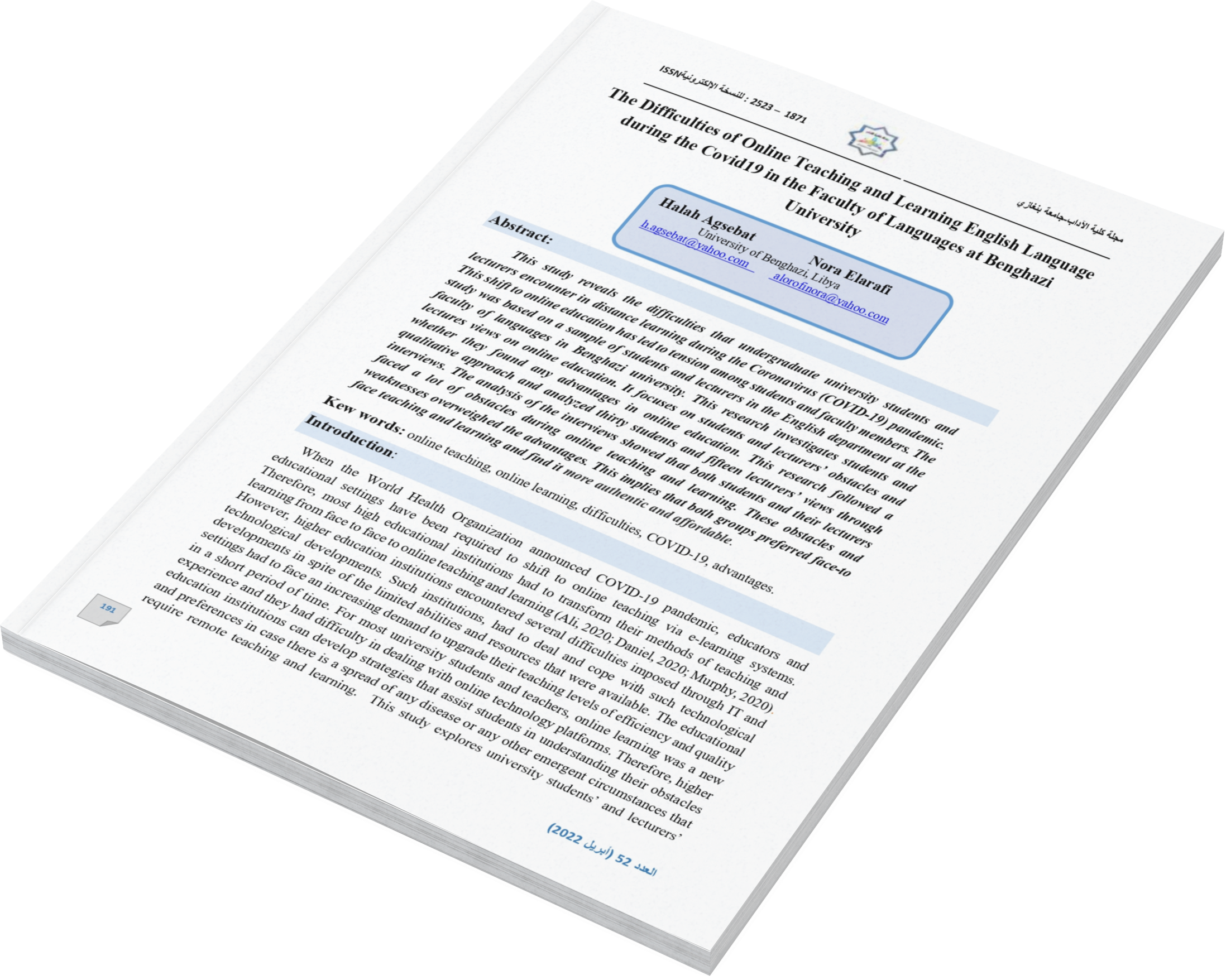The Difficulties of Online Teaching and Learning English Language during the Covid19 in the Faculty of Languages at Benghazi University
DOI:
https://doi.org/10.37376/jofoa.vi52.4596Keywords:
online teaching,, online learning, difficulties, COVID-19, advantagesAbstract
This study reveals the difficulties that undergraduate university students and lecturers encounter in distance learning during the Coronavirus (COVID-19) pandemic. This shift to online education has led to tension among students and faculty members. The study was based on a sample of students and lecturers in the English department at the faculty of languages in Benghazi university. This research investigates students and lectures views on online education. It focuses on students and lecturers’ obstacles and whether they found any advantages in online education. This research followed a qualitative approach and analyzed thirty students and fifteen lecturers’ views through interviews. The analysis of the interviews showed that both students and their lecturers faced a lot of obstacles during online teaching and learning. These obstacles and weaknesses overweighed the advantages. This implies that both groups preferred face-to face teaching and learning and find it more authentic and affordable.
Downloads
References
- Adov, L. & Mäeots, M. (2021). What can we learn about science teachers’ technology use during the COVID-19 pandemic? Education Sciences, 11(6): 255. https://doi.org/10.3390/ educsci11060255
- Aguilera-Hermida, A. P. (2020). College students’ use and acceptance of emergency online learning due to COVID-19. International Journal of Educational Research Open, 1, 100011.
- Ali, W. (2020). Online and remote learning in higher education institutes: A necessity in light of COVID-19 pandemic. Higher education studies, 10(3), 16-25.
- Almahasees, Z., Mohsen, K., & A min, M. O. (2021). Faculty’s and students’ perceptions of online learning during COVID-19. Available: https://www. frontiersin.org
- Al-Mawee, W. & Gharaibeh, T. (2021). Students’ perspective on distance learning during COVID-19 pandemic: A case study of Western Michigan University, United States. International Journal of Education Research Open, 2(2021) 100080.
- Bryman, A. (2012). Social Research Methods. Oxford, Oxford university press.
- Danchikov, E. A., Prodanova, N. A., Kovalenko, Y. N., & Bondarenko, T. G. (2021). Using different approaches to organizing distance learning during the COVID-19 pandemic: Opportunities and disadvantages. Linguistic and Cultural Review, 5(1): 587-595.
- Daniel, S. J. (2020). Education and the COVID-19 pandemic. Prospects, 1–6 https://www.scopus.com/home.uri
- Dhole, S., Tiwari, M., Andhare, R., Gabhance, S., & Dakhode, S. (2021). COVID-19 and academics-advantages and disadvantages. Journal of Medical Pharmaceutical and Allied Sciences, 10(3): 2961-2964.
- EDHEC Business School. (2021). The pros and cons of distance education. Availale: https://www.google.com
- GarcíaBotero, G., Questier, F., Cincinnato, S., He, T., & Zhu, C. (2018). Acceptance and usage of mobile assisted language learning by higher education students. Journal of Computing in Higher Education, 30(3): 426–451. 10. https://doi.org/10.1007/s12528-018-9177-1
- Gialamas, V. & Nikolopoulou, K. (2010). In-service and pre-service early childhood teachers’ views and intentions about ICT use in early childhood settings: A comparative study. Computers and Education, 55(1): 333-341. https://doi.org/10.29329/ijpe.2020. 329.26
- Gray, D. E. (2014). Doing research in the real world. Los Angeles, Sage.
- Guba, E. G. & Lincoln, Y. S. (1994). Competing Paradigms in Qualitative Research. Handbook of Qualitative Research, 2,163-194
- Isaeva, R., Eisenschmidt, E., Vanari, K., & Kumpas-Lenk, K. (2020). Students’ views on dialogue: improving student engagement in the quality assurance process. Qual. High. Educ. 26, 80–97. doi: 10.1080/13538322.2020. 1729307
- Moorhouse, B. L. & Kohnke, L. (2021). Thriving or surviving emergency remote teaching necessitated by COVID-19: University teachers’ perspectives. Aisa Pacific Edu Res, 30(3): 279- 287.
- Multirank Universities. (2021). U-multirank covid-19 radar: Implications of covid-19 from the students’ perspective. Available: https://www.umultirank.org
- Murphy, M. P. A. (2020). COVID-19 and emergency eLearning: Consequences of the securitization of higher education for post-pandemic pedagogy. Contemporary Security Policy. https://www.tandfonline.com/doi/full/10.1080/13523260.2020.1761749
- Nambiar, D. (2020). The impact of online learning during COVID-19: students’ and teachers’ perspective. The International Journal of Indian Psychology, 8(2). DOI: 10.25215/0802.094. Retrieved from http://www.ijip.in
- Orhan, G., & Beyhan, O. (2020). Teachers’ perceptions and teaching experiences on distance education through synchronous video conferencing during Covid-19 Pandemic. Social Sciences and Education Research Review, 7(1): 8–44. Retrieved from https://www.researchgate.net/profile/Sigridur_Olafsdottir2/publication/344025173
- Ramij, Md. G. & Sultana, A. (2020). Preparedness of Online Classes in Developing Countries amid COVID-19 Outbreak: A Perspective from Bangladesh. Available at SSRN: https://ssrn.com/abstract=3638718 or http://dx.doi.org/10.2139/ssrn.3638718
- Sayeh, A. Y. & Razkane, H. (2021). Moroccan high school EFL teachers’ attitudes and anxiety on using Microsoft Teams platform. TESOL and Technology Studies, 2(2): 29-40. https://sabapub.com/index.php/tts/article/view/267
- Sokal, L., Trudel, L. E., & Babb, J. (2020). Canadian teachers’ attitudes toward change, efficacy, and burnout during the COVID-19 pandemic. International Journal of Education Research Open, 1(2020)100016.

Downloads
Published
How to Cite
Issue
Section
License
Copyright (c) 2024 Journal of the Faculty of Arts

This work is licensed under a Creative Commons Attribution-NonCommercial-NoDerivatives 4.0 International License.




